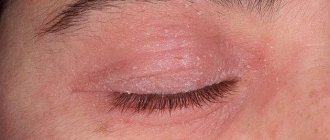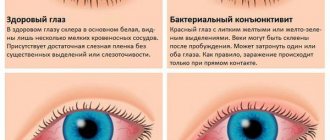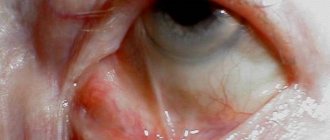One of the most common ophthalmological diseases in children and adults is obstruction of the lacrimal ducts.
The resulting blockage of the tear ducts is medically called dacryocystitis.
This pathology manifests itself with the same symptoms as many other eye diseases, which makes it necessary to undergo examination by a specialist at the first problems with the eyes. An accurate diagnosis is necessary to prescribe the correct treatment.
Statistical data from medical practice indicate that most often the pathology of the lacrimal ducts is diagnosed in women whose age is from 30 to 60 years. At the same time, men encounter this disease much less often.
Causes
The development of dacryocystitis occurs, as a rule, when the lacrimal canal is clogged or obstruction of the nasal canals is noted. In this case, blockage of the tear ducts can be caused by the following reasons:
- development of stenosis of the lacrimal canals from birth, disorders associated with the vascular system and lacrimal ducts;
- damage to the maxillofacial part;
- the presence of pathologies that can negatively affect the functioning of the nasolacrimal ducts;
- the presence of tuberculosis of the lacrimal sacs;
- inflammatory process on the eyelids.
Often, a violation can occur against the background of various congenital pathologies that appeared during the period of intrauterine development.
The principle of operation of the tear duct
A tear is a biological fluid that performs important functions in the human body. It moistens the eye, protects it from dryness and saturates it with nutrients. In addition, tears have a disinfecting function and protect the mucous membrane from the effects of pathogenic microorganisms. Tear fluid is removed from the eye through the lacrimal ducts, and during the intrauterine development of the child they remain covered with a gelatinous film. It helps prevent amniotic fluid from entering the child’s body through the respiratory system.
After the baby is born, the gelatin film breaks and the tear duct opens. However, in some situations this does not happen and the child is diagnosed with congenital obstruction of the lacrimal duct. This pathology can be detected in older children and even adults.
Symptoms
Atresia of the lacrimal duct can manifest itself at different periods of a person’s life. The disorder may affect one or both canals. Most often, the symptoms of the disorder are directly related to the root cause of the blockage. The most common symptoms of blocked tear ducts are:
- noticeable decrease in visual acuity;
- bloody impurities in the lacrimal sac;
- traces of purulent discharge on the affected eye;
- swelling of the eye, which causes pain;
- an inflammatory process develops, which is displayed on the lacrimal sac and eyeball;
- the eyes become very watery, and a significant excess of fluid appears in the lacrimal sacs.
The similarity of the symptoms of dacryocystitis and ordinary inflammation in many cases misleads patients.
Many other ophthalmological diseases also have a similar clinical picture. The only distinguishing sign of the disease from other disorders is swelling of the eyelids, which is accompanied by redness and soreness. When you press on the tear ducts, pus should appear.
Symptoms
The clinical manifestations of the disease are distinguished by specific symptoms and signs, which does not cause difficulties in determining the diagnosis.
However, the acute and chronic forms exhibit different clinical pictures.
Of the general symptoms that appear with dacryocystitis of any etiology and form, the following are noted:
- uncontrolled excessive release of tear fluid from the affected eye;
- purulent discharge;
- swelling in the area of the lacrimal sac;
- painful sensations;
- inability to fully open the eye due to swelling and pain;
- the likelihood of an increase in general temperature indicators.
The appearance of at least one of the described symptoms is a reason to visit an ophthalmologist in order to prevent further progression of the disease.
Clinical picture in acute course
Acute dacryocystitis is characterized by particularly severe symptoms:
- expressive hyperemia of the skin in the area of inflamed ducts;
- intense pain in the corner of the affected eye;
- significant swelling of the upper and lower eyelids, which is accompanied by their almost complete closure;
Associated symptoms include headache, chilliness, general weakness, and a slight increase in body temperature.
Symptoms in chronic form
The advanced state of the disease is accompanied by:
- uncontrolled release of fluid;
- the formation of a dense formation in the lacrimal sac - a purulent abscess, as a result of which the skin in this place acquires a bluish tint and becomes thin;
- in the absence of treatment, there is a possibility of fistula formation - internal or external.
Chronic dacryocystitis is dangerous due to its complications, including diseases such as blepharitis, conjunctivitis, phlegmon and even meningitis.
Diagnostics
When the first problems with your eyes appear, you should seek help from a specialist for diagnosis and diagnosis. If ocular dacryocystitis is suspected, a collarhead test is required to determine the source of inflammation and the level of patency of the canal. Using this procedure, the doctor can distinguish dacryocystitis from conjunctivitis, which has similar symptoms.
Also in the process of diagnosing the disease, the following examination methods are prescribed:
- biomicroscopy of eyeballs;
- probing;
- radiography of the eyes;
- culture of secretions;
- sample of material from the nasolacrimal duct.
Prognosis and complications
With high-quality treatment carried out in a short time, the prognosis is favorable. Complications may include:
- Cellulitis (abscess of the lacrimal sac): the spread of suppuration to nearby tissues causes swelling. Complicated by the development of sinusitis and corneal damage.
- Corneal ulcer: destruction of corneal tissue due to infection - spread of infection beyond the lacrimal sac. In non-infectious cases, insufficient corneal moisture leads to dry eye syndrome. This serves as a concomitant factor in dacryocystitis.
- Thrombophlebitis of the eye orbit: the spread and settling of microorganisms from foci of infection on the walls of the veins leads to blockage of the veins and the appearance of their pattern under the skin, difficulty in the movement of the eyeballs.
- Endophthalmitis: develops when a purulent process perforates (penetrates) into the internal structures of the eye.
The complication develops both locally and spreading throughout the body. Such complications include sepsis, meningitis, which can lead to disability and death.
Treatment
Treatment therapy may vary depending on various factors. To ensure that treatment is as effective as possible, specialists use a set of measures. Such therapy should contain not only drug treatment, but also massage, which accelerates the process of restoring normal functioning of the tear ducts. In cases where therapy does not produce the expected results, surgery may be used to eliminate the pathology.
Drug therapy
Most often, drug treatment is used after surgery, since such drugs can speed up the recovery process. It should be noted that the main task of medical products is to stop the manifestation of symptoms of pathology and prevent re-inflammation.
The most effective medications for treating blocked tear ducts are:
- Paracetamol;
- Tobrex;
- Vigamox;
- Oftaquix;
- Gentamicin.
Massotherapy
One of the additional methods of treating blocked tear ducts is a special massage. As a rule, this procedure is an addition to drug therapy. Before starting the procedure, you should thoroughly wash your hands and disinfect them. The procedure is performed with fingers with short nails.
This point is one of the most important. Before starting, you should clean the lacrimal opening; for this, use a cotton swab soaked in a weak solution of furatsilin. The use of gauze swabs should be avoided as they may leave behind small lint that is difficult to remove.
The duration of the massage should be no more than 10 minutes. The entire procedure includes jerky movements of the fingers without much effort, which are moved along the small tubercles that appear in the inner corner of the eye. During such a massage, the lacrimal sacs should be filled with purulent discharge from the lacrimal canals. It becomes necessary to clean the eye with a cotton swab. At the end, the affected eye must be instilled with eye drops prescribed by a specialist. On the recommendation of an ophthalmologist, massage can be done at least 5 times a day. The duration of the treatment course is 1-2 weeks.
Operation
Surgical intervention is prescribed in cases where medications do not give the expected result. Also indications for surgery are tumors and congenital obstruction of the lacrimal canals.
The main direction of the operation is to restore the normal functioning of underdeveloped and damaged tear ducts. Most often, dacryocystorhinostomy is prescribed, during which the normal outflow of tear fluid is restored.
If the operation is successful, the patient should undergo a long course of medication aimed at restoring the normal functions of the tear ducts. At this stage, sprays are prescribed to help eliminate swelling of the mucous membranes. Anti-inflammatory and antimicrobial eye drops are also required.
Complications
Dacryocystitis is dangerous because it can provoke various purulent complications. The chronic form of this disease poses a particular risk. With it, infection of other membranes of the eye is possible, which leads to conjunctivitis, blepharitis, and keratitis. Next, the cornea is damaged and a purulent ulcer forms. A complication of this process is an eyesore that reduces the quality of vision. Other possible consequences of chronic dacryocystitis:
- endophthalmitis;
- orbital phlegmon;
- sepsis;
- thrombosis of the cavernous sinus;
- inflammation of brain tissue and meninges;
- thrombophlebitis of the orbital veins.
Prevention
There is no single correct method to prevent the development of pathology, since there are many provoking factors. In this case, there are several ways that will help reduce the likelihood of developing a blockage:
- compliance with personal hygiene rules;
- Avoid touching your eyes with your hands;
- you need to limit communication with people who have various eye diseases of an infectious nature;
- it is important to strengthen the immune system by playing sports and walking in the fresh air;
- You should eat right and enrich your diet with healthy foods.
Compliance with all these points will not provide 100% protection, but will help reduce the likelihood of developing pathology.
Folk remedies
Treatment with folk remedies can only help with early diagnosis of the disease and if it appeared at birth and was not acquired due to another type of pathology. You can use herbs and plants after consultation with a specialist, because... independent use will harm the human body. The most popular folk remedies:
- Kalanchoe juice. The plant causes irritation of the mucous membrane, disinfecting and removing inflammation in the lacrimal ducts. To prepare the medicine, you need to pick the leaves, wash them, wrap them in a clean cloth and put them on the refrigerator shelf for several days. After this, they need to be crushed and squeezed out the juice. It is better to dilute it with saline solution 1:1. The resulting solution should be instilled one drop into each nostril. Kalanchoe will cause a long-term attack of sneezing, while the tear ducts will be cleared of pus.
- Chamomile. Rinsing the lacrimal canal in adults can be done using a decoction of a medicinal plant. To do this, pour 2 tbsp boiling water. l. chamomile and leave for 20 minutes. Then you need to moisten a cotton swab in the prepared broth and apply it to the affected area. The compress should be warm, not hot. The procedure must be repeated 2-3 times a day.











